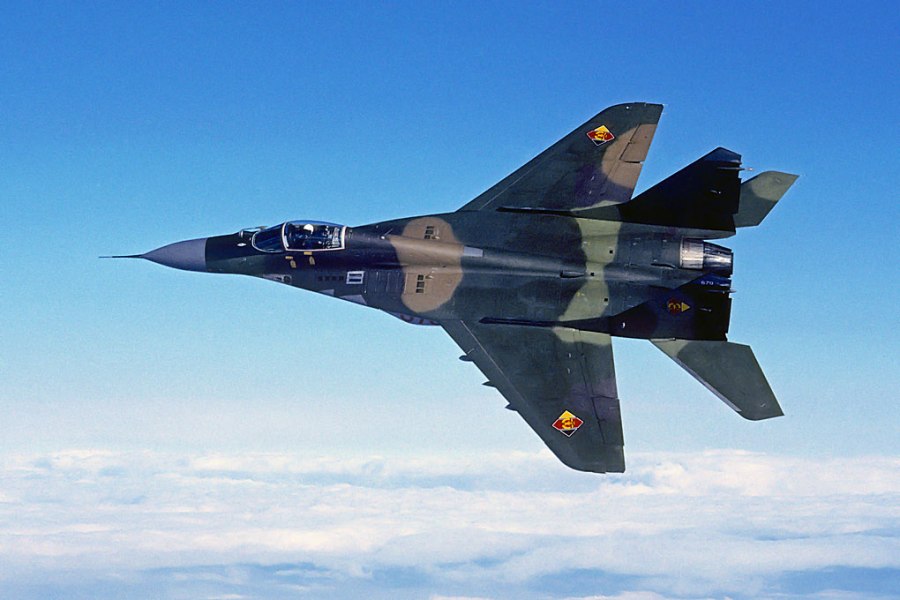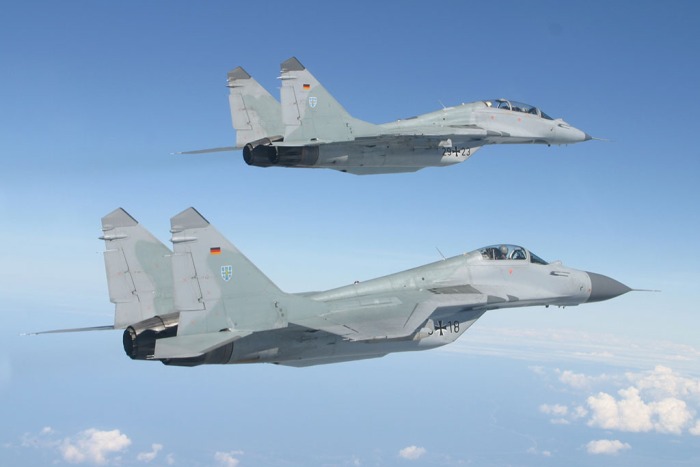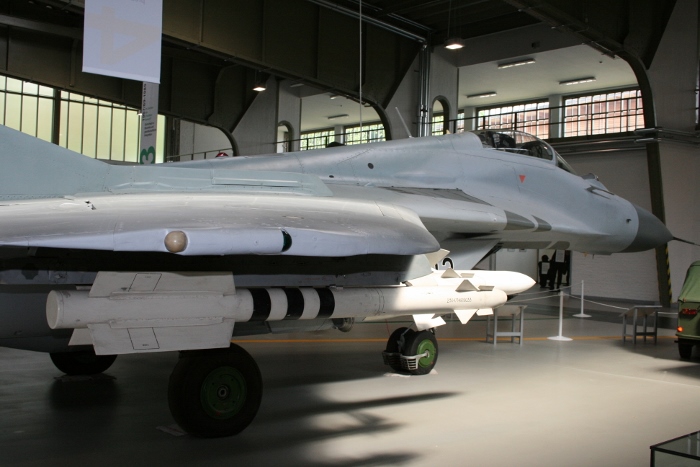
The East German Air Force (Luftstreitkräfte der Nationalen Volksarmee – LSK) operated as a well-trained and well equipped division of the National People’s Army (NPA or Nationalen Volksarmee – NVA) from 1956 through to their final year of operation in 1990. In 1989 the LSK was manned by 35,000 personnel and operated approximately 700 aircraft and helicopters. The Soviet Union also had a large concentration of military ground and air forces based in the GDR which operated alongside the NVA.
The initial opening of sections of the Berlin Wall in 1989 and the reunification of Germany in 1990 was a significant moment in ending the Cold War and a stepping stone to the breaking up of the Warsaw Pact, the end of Communism in Eastern Europe and the end of the Soviet Union in 1991. The last official day of the LSK was October 2nd, 1990 but flight operations ceased on September 30th, 1990.

Combat Jet Aircraft of the East German Air Force 1988 to 1990
MiG-29 Fulcrum – The last GDR Eagle
Although the LSK ceased to exist from late 1990 onwards, this was not in the long-term planning of the Soviet Union or the GDR in the 1980’s, so from 1988 to 1989 the LSK received the best combat aircraft that had ever flown for them in the form of the Mikoyan Gurevich MiG-29 Fulcrum multi-role fighter (primarily used for air defence by the LSK) which featured a helmet mounted weapons sight (not available in western jets until around 2003), advanced targeting equipment (the Archer system was able to lock-on to targets 45° off-boresight) and high maneuverability which when all combined in close range combat made the fighter more or less an equal of any combat aircraft they would potentially face flying in NATO nations. They were armed with a 30m GSh-30-1 cannon and could carry up to 6 air to air missiles including heat-seeking short-range Vympel R-73 / AA-11 “Archer” missiles and heat-seeking / radar-homing medium-range Vympel R-27 / AA-10 “Alamo” missiles along with air to ground ordnance. 24 Mikoyan Gurevich MiG-29’s were delivered to the LSK, serving with JG-3 at Preschen (20 MiG-29As and 4 MiG-29UB two-seat trainers) and they ultimately became the last of the GDR eagles to ever soar again.



The downside of the LSK MiG-29’s was that unlike earlier fighters they had operated, these MiG-29A’s were not the most advanced Soviet variants. Issues included an inferior radar, limited navigation and communications equipment and a limited internal fuel range with no air-to-air refuelling capability.






The Fulcrum joins the Luftwaffe
Although an eastern type, with operational limitations and not compatible with NATO systems, the MiG-29 was seen as being so good, the reunified Luftwaffe decided to keep the type in service following extensive testing and evaluation in 1991 by the Test and Evaluation Center 61 (WTD 61) in Manching (operating 2 MiG-29A and 2 MiG-29UB). Initially flight hours were kept to a set minimum each week to ensure the fighters were kept airworthy and serviceable whilst being tested and whilst an ongoing source of spares was assured from Russia.
As part of the initial Luftwaffe testing and evaluation, 4 MiG-29’s were sent to Jagdgeschwader 71 (Fighter Wing 71) “Richthofen” at Wittmundhafen for air combat training against Luftwaffe McDonnell Douglas F-4F Phantom II fighters from March 4th to March 27th, 1991 and other training occurred in Sardinia, Italy during April 1991. Some of the MiG-29’s were also operated in the air combat training capacity by the Luftwaffe in the United States from 1991 for around 1.5 years.

On July 25th, 1991 acceptance testing was successfully completed. From June 1993 the MiG-29 served with Jagdgeschwader 73 (Fighter Wing 73) “Steinhoff” based near Rostock. For the next 10 years the MiG-29 became part of the German air defence strategy alongside F-4F Phantom II fighters and also operated in the aggressor role for Luftwaffe and NATO pilot training (although Luftwaffe improvements were made to certain avionics and weapons systems, the limitations mentioned earlier of the avionics and radar system meant it was primarily suited to point air defence rather than lead air defence).


Luftwaffe MiG-29’s remained in service until 2003 when replaced by the Eurofighter Typhoon. The MiG’s were sold to Poland in September 2003 for a symbolic price of €1 per aircraft. At that time 23 remained as 1 was lost in an accident in 1996 but only 22 were sold as the other was put into the Luftwaffe Museum (14 of these aircraft went into operational Polish service).
Although by the time of retirement they were not as capable as current Russian versions due to them being early export variants and lacking ongoing upgrades (also the Soviets had removed some equipment such as the Lazlo data link which transmitted targeting information to the pilots HUD and the SRO IFF system from the jets prior to handing them over to Germany), operating the MiG-29 in the Luftwaffe provided excellent and invaluable air combat training for NATO pilots against a state of the art Soviet era fighter. This training in Europe, the United States and Canada proved useful against Soviet era aircraft including MiG-29’s in the Gulf War in 1991 and Serbian MiG-29’s over Kosovo in 1999 (6 were shot down over Kosovo by USAF and Dutch AF fighters).











So with the dawning of 1991 the LSK was gone but not forgotten. Fortunately they never had to go into combat and luckily a number of former LSK aircraft remain in museums today and the Luftwaffe Museum at the historic Berlin-Gatow airfield is the best place to see many of these survivors. I visited the museum in 2010, some 20 years after the fall of the GDR and was impressed with the collection of aircraft that once flew within Germany. Apart from the GDR and Luftwaffe historical photos I have included, the rest I have featured here were taken during that 2010 visit.
References:


I do like the Mig 29, it’s a gorgeous aircraft. A very informative post and great photos too. Thank you.
LikeLiked by 1 person
Thanks. They looked great in the old GDR scheme
LikeLiked by 1 person
I actually got to see an ex-East German Mi-14 Haze in the 1990s. It had all the weapons removed and was being used as a search and rescue helicopter The Bundesmarine pilot said that they were going to keep flying it until the next mandatory airframe-hours inspection, or, until it needed repairs; whichever came first. It looked weird to see a Soviet-made helicopter with the iron cross and NATO emblems on it. Anyways great post, I live the MiG-29 too.
LikeLiked by 1 person
Nice! I was inside one at the Technik Museum in Speyer in Dec 2015. Would have been nice to have seen it in operation though. Thanks
LikeLiked by 1 person